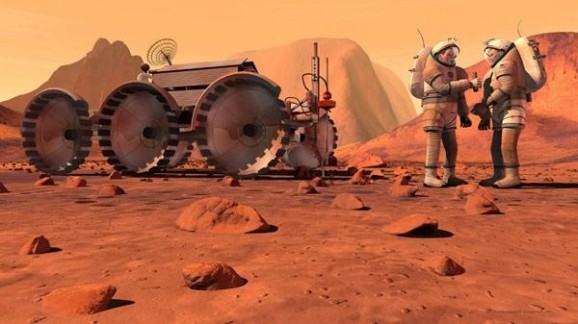The House Seems To Be Supporting Manned Flight To Mars
This article is more than 2 years old
 Perhaps the recent National Research Council report lambasting NASA’s plan to get humans to Mars was the wake-up call the government needed. That report (which somewhat ironically cost upwards of $3 million to assemble) couldn’t have been clearer in stating that, under current circumstances, NASA’s manned Mars missions were nothing but a pipe dream, and an invitation to “failure, disillusionment, and the loss of the longstanding international perception that human spaceflight is something the United States does best.” Yikes. But sometimes, a kick (or ten) in the ass is what the government needs, and when the House passed a new NASA reauthorization bill last week, it took the step in providing a more feasible budget for putting people on Mars.
Perhaps the recent National Research Council report lambasting NASA’s plan to get humans to Mars was the wake-up call the government needed. That report (which somewhat ironically cost upwards of $3 million to assemble) couldn’t have been clearer in stating that, under current circumstances, NASA’s manned Mars missions were nothing but a pipe dream, and an invitation to “failure, disillusionment, and the loss of the longstanding international perception that human spaceflight is something the United States does best.” Yikes. But sometimes, a kick (or ten) in the ass is what the government needs, and when the House passed a new NASA reauthorization bill last week, it took the step in providing a more feasible budget for putting people on Mars.
Just before the bill passed the House, Steven Palazzo, Chairman of the Space Subcommittee of the House Science, Space and Technology Committee, said, “We are committed to once more launching American astronauts, on American rockets, from American soil,” and argued that the bill would “serve as a pathway to Mars.” The bill also reinforces Obama’s previous commitment to developing a cutting-edge heavy-lift rocket launcher, as well as the new generation of Orion spacecraft, which is currently undergoing testing.
The new bill, H.R. 4412, authorizes one year of funding — a grand total of $17,646,500,000 of funding for fiscal year 2014. Of that amount, over $4 billion is allocated for space exploration. Roughly $1.9 billion of that amount is for the Space Launch System, and approximately $1.2 billion is for the Orion capsule. Just over $300 million is allocated to exploration research and development, and just under $696 million is for commercial crew development activities.
The new bill also articulates policy regarding space exploration. “Human exploration deeper into the solar system shall be a core mission of the Administration,” it says, and refers specifically to a “crewed mission to the surface to Mars to begin human exploration of that planet.” The bill calls upon NASA to devise a “human exploration road map” outlining its next steps and goals for space exploration, including intermediate destinations, cost analysis, management strategies, the technologies that will be required to make that happen. The bill also encourages inviting the United States’ partners in the ISS to collaborate on international initiatives to explore Mars, particularly when it comes to developing the necessary technology.
The bill, which has been hailed as a bipartisan effort, passed by a vote of 401-2. The Senate’s Commerce, Science, and Transportation Committee still needs to pass its own version of the bill, but this is a good start. While there are drawbacks — a one-year allocation, the question of whether these amounts are enough to do what they’re supposed to do, and the fact that a human exploration roadmap is easier said than done — the passage of the bill demonstrates a move in the right direction. Let’s hope the government and NASA can continue building on it.












